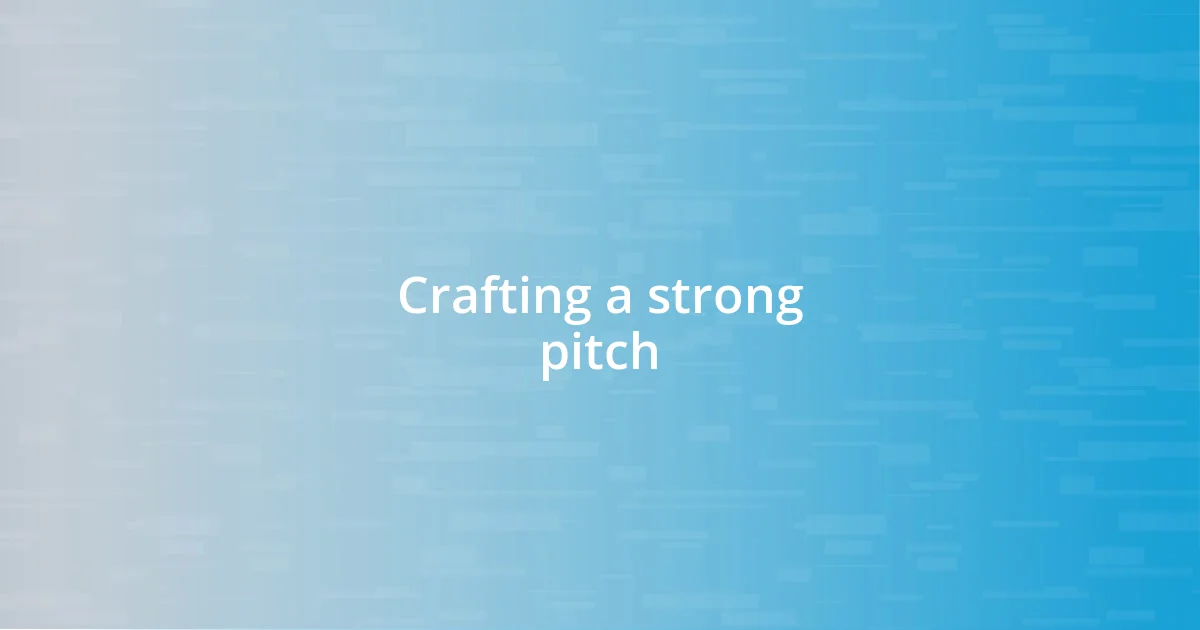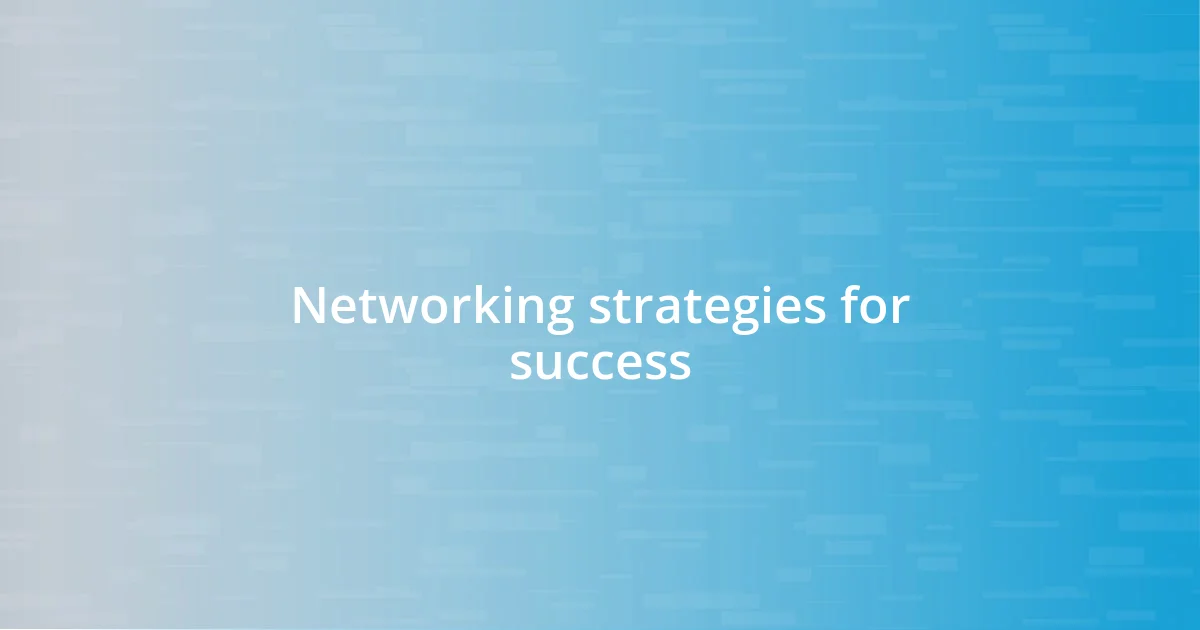Key takeaways:
- Identify potential sponsors by aligning their values with your mission and leveraging personal networks for connections.
- Craft compelling proposals by focusing on clarity, measurable outcomes, and authentic storytelling to resonate with sponsors.
- Build relationships through genuine interaction and consistent follow-up, emphasizing the importance of communication in developing partnerships.

Understanding sponsorship opportunities
Understanding sponsorship opportunities requires more than just recognizing potential partners; it’s about identifying how their goals align with your vision. I remember the first time I approached a brand for sponsorship—my heart raced at the thought of rejection. But I realized that many companies are seeking to connect with passionate individuals who share their values. Have you considered which brands resonate with you on a personal level?
As I navigated the sponsorship landscape, I learned that it’s crucial to articulate what you can offer in exchange. When I crafted my proposal, I focused on what made my audience unique, and it struck a chord with potential sponsors. Isn’t it fascinating how a clear value proposition can open doors you never expected?
In my experience, building relationships plays a key role in securing sponsorships. I still remember attending events and engaging with representatives, not just to pitch but to genuinely connect. It’s this personal touch that often leads to more fruitful partnerships. How do you think building authentic connections could influence your own sponsorship journey?

Identifying potential sponsors
Identifying potential sponsors starts with introspection. I take time to list brands that align with my passion and mission. For instance, during my project on environmental awareness, I targeted companies already working in sustainability. Reflecting on shared values not only simplifies your search but also boosts your confidence when reaching out.
In my journey, I found that research brings clarity. Using social media, I looked into brands that engaged with communities similar to mine—this led to fruitful conversations and unexpected partnerships. The thrill of a brand recognizing my work was exhilarating, and it reaffirmed the idea that the right alignment can spark genuine interest.
The importance of community cannot be overstated. I experienced this firsthand when I connected with a local business through mutual contacts. Their representative expressed enthusiasm about working together because they valued grassroots initiatives. Have you ever thought about how your network could reveal sponsorship opportunities?
| Criteria for Identifying Sponsors | My Experience |
|---|---|
| Brand Values Alignment | Targeted brands focused on sustainability during environmental projects. |
| Active Community Engagement | Brands that interact with similar audiences led to successful partnerships. |
| Utilizing Personal Networks | Leveraging local contacts revealed unexpected sponsorship prospects. |

Building a compelling proposal
When it comes to building a compelling proposal, clarity is your best friend. One of my first proposals was a confusing jumble of ideas, and I learned the hard way that simplicity is key. I began structuring my proposals by clearly outlining objectives, benefits, and expected outcomes for potential sponsors. This approach allowed them to see the direct value in partnering with me, almost as if I was giving them a roadmap to success.
Here are some essential elements I focus on when crafting proposals:
- Clear Objectives: What exactly do you want to achieve?
- Value Proposition: How does your audience align with the sponsor’s target market?
- Measurable Outcomes: What metrics can you share that demonstrate success?
- Creative Solutions: Can you propose unique ways the sponsor can engage with your audience?
- Personal Touch: Sharing a story can humanize your proposal and build connection.
I remember submitting a proposal for a community event; I woven in a personal story of how a local shop supported my growth. It turned out to be the deciding factor for that shop— they saw their values reflected in my narrative. The process taught me that authenticity can resonate deeply, setting the stage for a potential partnership. How do you think your unique story could add depth to your own proposals?

Crafting a strong pitch
Crafting a strong pitch requires understanding your audience and speaking directly to their needs. I remember one time when I tailored my approach for a local arts festival. Instead of just presenting the numbers, I emphasized the community impact—the joy of bringing together local artists and enhancing cultural engagement. This reflection made my pitch resonate, showing that I was invested in a shared vision.
Another crucial aspect is the art of storytelling. When I pitched to a tech company, I shared a pivotal moment in my project—how our initiatives empowered a group of underprivileged teens to explore careers in technology. This narrative didn’t just showcase numbers; it created an emotional connection. Have you considered how your stories can transform a straightforward pitch into something that sticks with potential sponsors?
Lastly, always be prepared for questions. I’ve been in situations where sponsors were eager to dig deeper into my plans, and my confidence came from knowing my material inside and out. Engaging in this back-and-forth turned what could have been a dry conversation into a dynamic exchange of ideas. How often do you practice anticipating questions to refine your pitch further?

Networking strategies for success
Networking can feel daunting, but it’s all about building authentic relationships. I’ve attended countless events where I found myself standing awkwardly, unsure of how to break the ice. I’ve learned to approach networking as a conversation, not a sales pitch. Instead of focusing solely on what I could gain, I actively listened and asked questions about others’ experiences. This shift in mindset not only eased my anxiety but also helped me forge lasting connections.
Another strategy that has worked wonders for me is following up after initial meetings. One time, I met a fellow entrepreneur at a conference and we had a great chat about our projects. I sent a quick email the next day, sharing an article relevant to our discussion. This simple gesture turned a one-off meeting into a budding professional relationship, filled with collaboration and shared insights. Have you ever thought about how a few thoughtful words can solidify a connection?
Finally, harnessing the power of social media can elevate your networking game significantly. I often share updates about my projects and insights on platforms like LinkedIn. This practice not only keeps me visible but also invites others to engage with me. When I posted about my latest sponsorship success, an old contact reached out and offered assistance for my next endeavor. It’s incredible how maintaining an online presence can open unexpected doors. How do you leverage your social media to amplify your networking efforts?

Following up with sponsors
Following up with sponsors is where the real magic happens. I still vividly recall a time I reached out to a sponsor a week after our initial conversation. I expressed my appreciation for their insights during our meeting and shared an intriguing article related to our discussion. This thoughtful gesture didn’t just keep me on their radar; it showed I valued our dialogue. Have you ever noticed how a timely follow-up can bridge the gap between a good conversation and a fruitful partnership?
In my experience, the follow-up is not merely a courtesy; it’s a crucial step in nurturing potential sponsorships. After securing a couple of enthusiastic responses, I took it further by asking for feedback on my project plans. Surprisingly, sponsors often appreciate being included in the conversation—not just as funders, but as partners. How do you approach these interactions to turn a one-time pitch into an ongoing partnership?
I’ve learned that being genuine and consistent in my follow-up can set me apart. There was a moment when I sent personalized updates to sponsors throughout a project, not just at funding milestones. Sharing triumphs and challenges not only built trust but transformed my sponsors into active supporters. Have you considered how cultivating ongoing communication can transform your relationship with sponsors into something more meaningful?

Measuring sponsorship effectiveness
Measuring the effectiveness of sponsorship can often feel like deciphering a complex puzzle. From my experience, it’s critical to set clear objectives before the sponsorship begins. For instance, I recently targeted an increase in brand awareness and engaged my sponsors in setting specific metrics to evaluate this. Whether it’s tracking website traffic or monitoring social media engagement, having those benchmarks in place keeps the partnership accountable and productive. Have you thought about how your goals can shape the entire sponsorship experience?
I’ve discovered that qualitative feedback is just as essential as hard numbers. After one sponsorship campaign, I reached out to attendees for their thoughts on our activations. Their insights not only highlighted what worked well but also revealed areas ripe for improvement. I remember receiving a heartfelt response from an attendee who mentioned feeling inspired by the brand’s presence. That moment affirmed to me that the emotional connection we made was as critical as any statistic. How do you gather feedback to assess the broader impact of your sponsorship efforts?
Ultimately, I believe the true measure of sponsorship effectiveness lies in the relationships fostered. After a successful campaign, I took time to reflect on the partnerships that blossomed during that process. A sponsor I connected with ended up becoming a mentor, guiding me through my next big project. This reminded me that beyond the metrics, it’s the human connections and mutual growth that define success. Have you ever evaluated how relationships can be the most meaningful indicator of your sponsorship accomplishments?
















